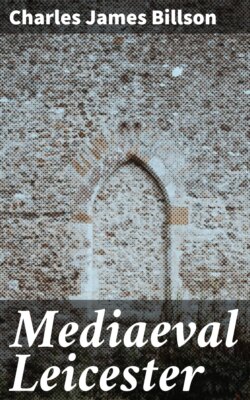Читать книгу Mediaeval Leicester - Charles James Billson - Страница 10
На сайте Литреса книга снята с продажи.
III. THE SOUTH QUARTER.
ОглавлениеTable of Contents
The South quarter of the mediaeval town was bounded on the North by the Hot Gate and Apple Gate leading to the West Gate and Bridge; and on the West by the river. On the East lay the old High Street, and on the South, until the middle of the 14th century, the South wall of the town, and after that time the Newarke.
There were few roads and few houses in this quarter, which comprised chiefly the Castle and its precincts, with St. Mary's Church, beyond which lay the 14th century Newarke, the whole enclosed by strong walls. Here too were butchers' shambles and bakers' ovens.
The mediaeval streets were the main intersecting highway, consisting of the Hot Gate and the Apple Gate, Red Cross Street, and Soar Lane or St. Mary's Church Lane. The lane running South of the Newarke from the High Road to the Mill on the River was called Mill Lane in the middle of the 14th century.
The Hot Gate is mentioned in 1297, when John the Noble belied his name by committing a burglary there. It was known as "vicus calidus," or Hot Gate, because the public ovens were situated in that locality. A conveyance, dated 1362, of a house in the Hot Gate to a baker, is extant. The memory of the ovens which once warmed this part of the town is still kept alive by the name of Bakehouse Lane, or Fosbrooke Bakehouse Lane, a street which was comprised under the same name in the eleventh Ward of 1484. In the year 1586 the Hot Gate was described in a Lease as "Hot Gate, late the lane of the common oven." Nichols and North erroneously identified it with Silver Street, but its position is clearly determined by the Ward division of 1484, wherein the tenth Ward began "at the High Cross southward on both sides the street unto the Grey Friars' Lane and the Soar Lane, the Hot Gate and so forth to the West Bridge." It is now called St. Nicholas Street.
Applegate, the continuation of Hot Gate towards the West Bridge, still bears the same name. In the 14th century it was known as Apple Lane. In 1349 a house in "Apple Lane" was described as adjoining the bakehouse of the Earl and stretching from that lane to the Holy Bones. This identifies Apple Lane with Apple Gate. The same, or another house, described in 1471 as being in the Applegate and adjoining the King's bakehouse, also stretched to the Holy Bones. It would seem that the street was also known as Shambles Lane, and that the common shambles of the butchers lay there. There was another Butchers' Shambles in the Saturday Market, which in time superseded the Applegate. In a 16th century petition the Company of Leicester Butchers expressed a wish to confine their business to the Saturday Market shambles, as the shambles in St. Nicholas Parish were then "out of the way of trading and remote from the inns and shopkeepers." In 1594 both butchers and bakers were tenants of the Borough in Applegate. Throsby says that Shambles Lane led to the West Bridge, and Nichols identifies it with Applegate. It has been suggested that the first part of the name "Applegate" may be the French word "appeller," and that it refers to the watchtower on the adjacent Castle Wall, where the sentinel used to "call" the hour of the night. But it may be derived, perhaps more naturally, from the former presence of apple trees.
Red Cross Street, which runs west from the old High Street, opposite Peacock Lane, still retains its old name. This is said by some to be derived from Rede, or Rood, quasi Rede or Rood Cross Street. But the Dean of St. Mary's de Castro in 1494 occupied a house belonging to the Corpus Christi Guild, which is described as being "ad rubiam crucem," and from other entries in the accounts of the Guild it may be inferred that this Red Cross was in Red Cross Street. It was called Red Cross Street in 1557, when the second of the ten town Wards was made to run from the South Gate unto the High Cross with the Soar Lane and Red Cross Street. In Speed's plan of Leicester a cross is shown at the junction of Red Cross Street and St. Mary's Church Lane.
The lane now called Soar Lane, which ran from the North Bridge to the river, outside the town wall, was in mediaeval times generally called Walker Lane, after the Walkers, or Fullers who dwelt there. It was named Soar Lane as early as 1458. But there was, at that time, another Soar Lane, in the South quarter, and the two were distinguished in the Rental of the Corpus Christi Guild of that date as "Soar Lane extra portam borialem," Soar Lane without the North Gate, and "Soar Lane juxta Castrum," or "Sorelane que ducit ad Castrum," Soar Lane near, or leading to, the Castle. The latter street ran out of the High Street towards Castle and river from a point nearly opposite to Friar Lane, as we may conclude from the boundaries of the tenth Ward in 1484. It is the lane mentioned in 1325, when some brawlers, after a dispute in the High Street, are said to have gone quarrelling to "the lane which leads to the Castle." The modern road which answers to this old Soar Lane seems to be the present Castle Street, "one of the most narrow entrances of the town" in the time of Throsby, which was formerly known as St. Mary's Church Lane.
